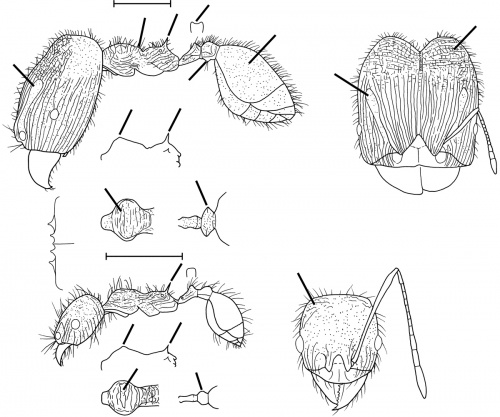Pheidole cubaensis
| Pheidole cubaensis | |
|---|---|

| |
| Scientific classification | |
| Kingdom: | Animalia |
| Phylum: | Arthropoda |
| Class: | Insecta |
| Order: | Hymenoptera |
| Family: | Formicidae |
| Subfamily: | Myrmicinae |
| Tribe: | Attini |
| Genus: | Pheidole |
| Species: | P. cubaensis |
| Binomial name | |
| Pheidole cubaensis Mayr, 1862 | |
| Synonyms | |
| |
Evidently a rare species: few collections have been made despite its conspicuously large size. I found a colony in Blanco’s Woods, Las Villas Province, Cuba, with winged reproductives on 25 June 1953. (Wilson 2003)
Identification
See the description in the nomenclature section.
Keys including this Species
Distribution
Cuba.
Latitudinal Distribution Pattern
Latitudinal Range: 23.133° to 22.131599°.
| North Temperate |
North Subtropical |
Tropical | South Subtropical |
South Temperate |
- Source: AntMaps
Distribution based on Regional Taxon Lists
Neotropical Region: Cuba (type locality), Greater Antilles.
Distribution based on AntMaps
Distribution based on AntWeb specimens
Check data from AntWeb
Countries Occupied
| Number of countries occupied by this species based on AntWiki Regional Taxon Lists. In general, fewer countries occupied indicates a narrower range, while more countries indicates a more widespread species. |

|
Estimated Abundance
| Relative abundance based on number of AntMaps records per species (this species within the purple bar). Fewer records (to the left) indicates a less abundant/encountered species while more records (to the right) indicates more abundant/encountered species. |

|
Biology
Castes
Worker
Minor
Images from AntWeb
    
| |
| Specimen code casent0601286. . | |
Major
Images from AntWeb
 
| |
| Lectotype Pheidole cubaensis. Worker (major/soldier). Specimen code casent0601285. Photographer John T. Longino, uploaded by California Academy of Sciences. | Owned by NHMV. |
Nomenclature
The following information is derived from Barry Bolton's Online Catalogue of the Ants of the World.
- cubaensis. Pheidole cubaensis Mayr, 1862: 747 (s.w.) CUBA. Senior synonym of grayi Mann: Wilson, 2003: 624.
- grayi. Pheidole cubaensis var. grayi Mann, 1920: 426 (s.w.) CUBA. [Unresolved junior primary homonym of grayi Forel, above.] Junior synonym of cubaensis: Wilson, 2003: 624.
Unless otherwise noted the text for the remainder of this section is reported from the publication that includes the original description.
Description
From Wilson (2003): DIAGNOSIS A large, dark reddish brown member of the scrobifera group.
Major: deep antennal scrobes present; rear third of the dorsal head surface rugoreticulate; propodeal spines moderately long and slender; postpetiole cornulate; a small subpostpetiolar process present; pilosity short, dense, and erect.
Minor: postpetiolar node diamond-shaped; propodeal spines long, slender, and straight; venter of head transversely carinulate; dorsa of head and mesosoma almost entirely foveolate and opaque.
A unique species, placed in the scrobifera group tentatively because of the habitus of the major, but the minor shows overall resemblance to the tristis-group species Pheidole alayoi, Pheidole macromischoides and Pheidole naylae of Cuba and Pheidole androsana of the Bahamas.
MEASUREMENTS (mm) Major (“var. grayi” syntype): HW 1.92, HL 2.16, SL 0.86, EL 0.20, PW 0.82. Minor (“var. grayi” syntype): HW 0.66, HL 0.72, SL 0.82, EL 0.14, PW 0.44.
COLOR Major and minor: body dark reddish brown, appendages dark yellow to yellowish brown.
Figure. Upper: major, syntype of var. grayi. Lower: minor, syntype of var. grayi.’’ Scale bars = 1 mm.
Type Material
CUBA: Limones. Naturhistorisches Museum Wien, Vienna - as reported in Wilson (2003)
Etymology
Named after the country of origin. (Wilson 2003)
References
- Mayr, G. 1862. Myrmecologische Studien. Verh. K-K. Zool.-Bot. Ges. Wien 12: 649-776 (page 747, soldier, worker described)
- Wilson, E. O. 2003. Pheidole in the New World: A dominant, hyperdiverse ant genus. Harvard University Press, Cambridge, MA.(page 624, fig. major, minor described, Senior synonym of grayi)
References based on Global Ant Biodiversity Informatics
- Alayo D. P. 1974. Introduccion al estudio de los Himenopteros de Cuba. Superfamilia Formicoidea. Academia de Ciencias de Cuba. Instituto de Zoologia. Serie Biologica no.53: 58 pp. La Habana.
- Field Museum Collection, Chicago, Illinois (C. Moreau)
- Fontanla Rizo J.L. 1997. Lista preliminar de las hormigas de Cuba. Cocuyo 6: 18-21.
- Fontenla J. L., and J. Alfonso-Simonetti. 2018. Classification of Cuban ants (Hymenoptera: Formicidae) into functional groups. Poeyana Revista Cubana de Zoologia 506: 21-30.
- Fontenla Rizo J. L. 1993. Mirmecofauna de Isla de la Juventud y de algunos cayos del archipielago cubano. Poeyana. Instituto de Ecologia y Sistematica, Academia de Ciencias de Cuba 444:1-7.
- Fontenla Rizo J. L. 1997. Lista preliminar de las hormigas de Cuba (Hymenoptera: Formicidae). Cocuyo 6: 18-21.
- Fontenla Rizo J. L., and L. M. Hernández. 1993. Relaciones de coexistencia en comunidades de hormigas en un agroecosistema de caña de azúcar. Poeyana. Instituto de Ecología y Sistemática, Academia de Ciencias de Cuba 438: 1-16.
- Frago E., E. Portuondo Ferrer, J. L. Fernandez Triana, O. Sariego, and J. G. Fonseca. 2010. Entomofauna del Parque Nacional 'Desembarco del Granma", Cuba Suroriental. Boletin de la Sociedad Entomologica Aragonesa 46: 355-362.
- Kempf, W.W. 1972. Catalago abreviado das formigas da regiao Neotropical (Hym. Formicidae) Studia Entomologica 15(1-4).
- Kusnezov N. 1963. Zoogeografia de las hormigas en sudamerica. Acta Zoologica Lilloana 19: 25-186
- Mann W. M. 1920. Additions to the ant fauna of the West Indies and Central America. Bulletin of the American Museum of Natural History 42: 403-439.
- Santschi F. 1930. Quelques fourmis de Cuba et du Brésil. Bulletin. Société Entomologique d'Egypte. 14: 75-83.
- Weber N. A. 1934. Notes on neotropical ants, including the descriptions of new forms. Revista de Entomologia (Rio de Janeiro) 4: 22-59.
- Wheeler W. M. 1905. The ants of the Bahamas, with a list of the known West Indian species. Bulletin of the American Museum of Natural History 21: 79-135.
- Wheeler W. M. 1913. The ants of Cuba. Bulletin of the Museum of Comparative Zoology 54: 477-505.
- Wilson, E.O. 2003. Pheidole in the New World: A Dominant, Hyperdiverse Genus. Harvard University Press



